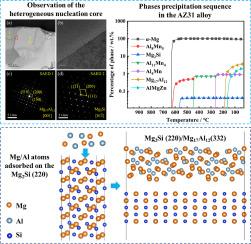当前位置:
X-MOL 学术
›
J. Magnes. Alloys
›
论文详情
Our official English website, www.x-mol.net, welcomes your
feedback! (Note: you will need to create a separate account there.)
Revealing the heterogeneous nucleation mechanism of Mg17Al12 on impurity Mg2Si particles in commercial AZ31 alloy
Journal of Magnesium and Alloys ( IF 15.8 ) Pub Date : 2024-08-27 , DOI: 10.1016/j.jma.2024.08.011 Liling Mo, Hengbin Liao, Linbo Chen, Yu-Jun Zhao, Jun Du
Journal of Magnesium and Alloys ( IF 15.8 ) Pub Date : 2024-08-27 , DOI: 10.1016/j.jma.2024.08.011 Liling Mo, Hengbin Liao, Linbo Chen, Yu-Jun Zhao, Jun Du

|
Silicon (Si) is an inevitable impurity element in the AZ31 alloy. In this study, the Si impurity was detected mainly as fine Mg2Si particles dispersed widely within the central region of the Mg17Al12 phase. During the solidification process, the Mg2Si particle precipitates at about 565 °C, before the Mg17Al12 phase of 186 °C, potentially acting as the heterogeneous nucleation core for the Mg17Al12 phase. The orientation relationship between Mg2Si and Mg17Al12 was investigated using the Edge-to-Edge matching model (E2EM) calculations, which showed a misfit of only 0.1 %. This low misfit suggests that Mg2Si can serve as a heterogeneous nucleation site for Mg17Al12. The surface and interface structures of Mg2Si (220) and Mg17Al12 (332) were constructed, and then investigated through the first-principles calculation. The theoretical results indicate that Mg and Al are easily adsorbed on the surface of Mg2Si, with Al showing higher adsorption energy than Mg. Furthermore, the interface between Mg2Si and Mg17Al12 exhibits favorable thermodynamic stability. Combined with experiments and theoretical calculations, it is confirmed that the Mg2Si particles, formed due to the Si impurity, provide effective heterogeneous nucleation sites for the Mg17Al12 phase.
中文翻译:

揭示 Mg17Al12 对商用 AZ31 合金中杂质 Mg2Si 颗粒的非均相形核机制
硅 (Si) 是 AZ31 合金中不可避免的杂质元素。在本研究中,Si 杂质主要以广泛分散在 Mg17Al12 相中心区域内的细小 Mg2Si 颗粒的形式进行检测。在凝固过程中,Mg2Si 颗粒在大约 565 °C 时析出,然后是 186 °C 的 Mg17Al12 相,可能充当 Mg17Al12 相的非均相形核核心。使用边到边匹配模型 (E2EM) 计算研究了 Mg2Si 和 Mg17Al12 之间的取向关系,结果显示失配仅为 0.1%。这种低失配表明 Mg2Si 可以作为 Mg17Al12 的异质成核位点。构建了 Mg2Si (220) 和 Mg17Al12 (332) 的表面和界面结构,然后通过第一性原理计算进行了研究。理论结果表明,Mg 和 Al 很容易吸附在 Mg2Si 的表面,其中 Al 的吸附能高于 Mg。此外,Mg2Si 和 Mg17Al12 之间的界面表现出良好的热力学稳定性。结合实验和理论计算,证实由于 Si 杂质形成的 Mg2Si 颗粒为 Mg17Al12 相提供了有效的非均相成核位点。
更新日期:2024-08-27
中文翻译:

揭示 Mg17Al12 对商用 AZ31 合金中杂质 Mg2Si 颗粒的非均相形核机制
硅 (Si) 是 AZ31 合金中不可避免的杂质元素。在本研究中,Si 杂质主要以广泛分散在 Mg17Al12 相中心区域内的细小 Mg2Si 颗粒的形式进行检测。在凝固过程中,Mg2Si 颗粒在大约 565 °C 时析出,然后是 186 °C 的 Mg17Al12 相,可能充当 Mg17Al12 相的非均相形核核心。使用边到边匹配模型 (E2EM) 计算研究了 Mg2Si 和 Mg17Al12 之间的取向关系,结果显示失配仅为 0.1%。这种低失配表明 Mg2Si 可以作为 Mg17Al12 的异质成核位点。构建了 Mg2Si (220) 和 Mg17Al12 (332) 的表面和界面结构,然后通过第一性原理计算进行了研究。理论结果表明,Mg 和 Al 很容易吸附在 Mg2Si 的表面,其中 Al 的吸附能高于 Mg。此外,Mg2Si 和 Mg17Al12 之间的界面表现出良好的热力学稳定性。结合实验和理论计算,证实由于 Si 杂质形成的 Mg2Si 颗粒为 Mg17Al12 相提供了有效的非均相成核位点。


















































 京公网安备 11010802027423号
京公网安备 11010802027423号